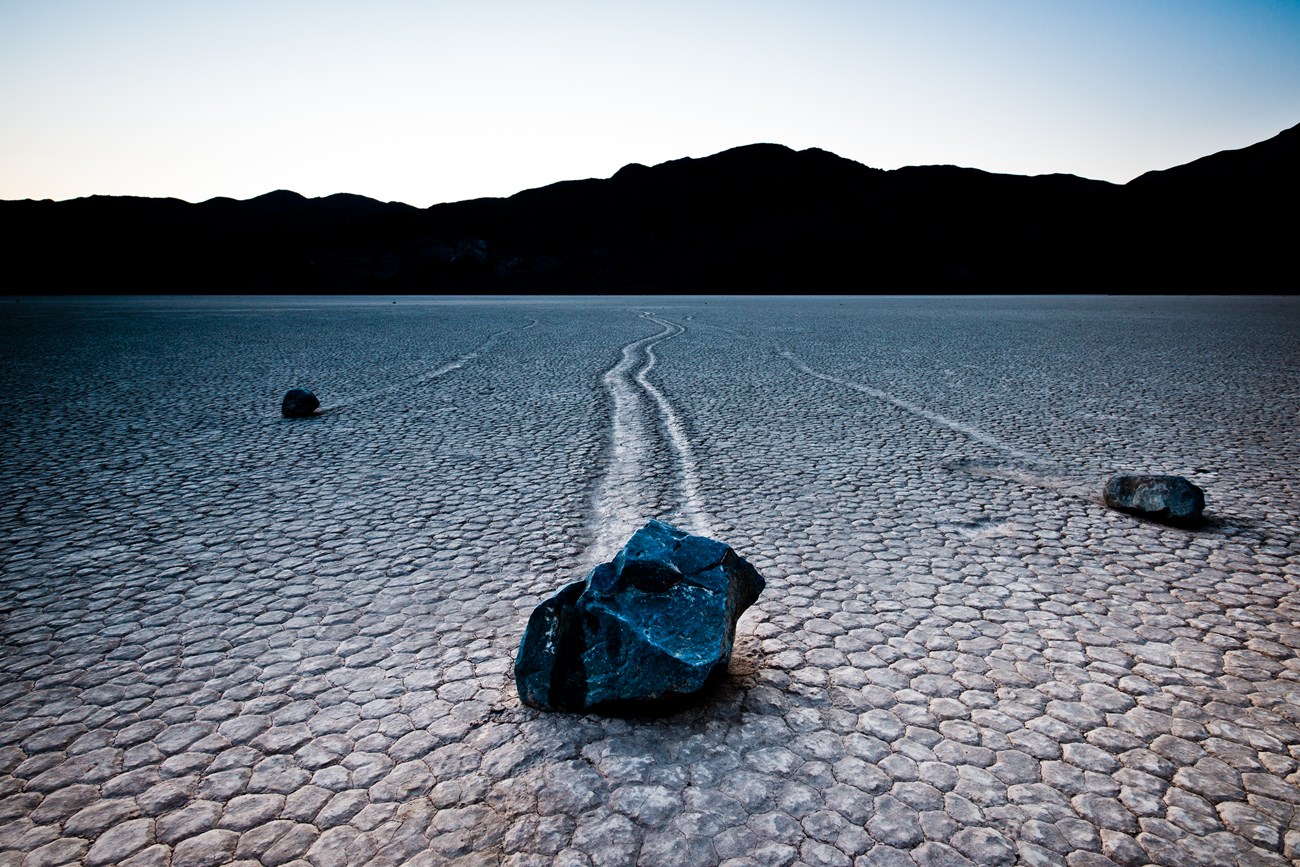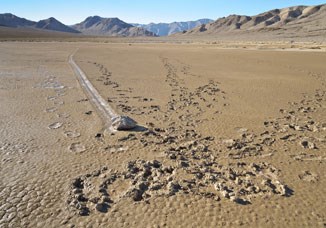
Jeffery Aiello Caution: Rough and Remote RoadThe road to the Racetrack is rough, and good tires, 4x4 and high clearance are usually required. Standard rental vehicles are not recommended, and often get flat tires. Use extreme caution on this road in the summer heat. There is no cell phone coverage in the area. Drive time from Furnace Creek is at least 3.5 hours each way. Other access roads make for even longer and more remote adventures. Driving offroad is strictly prohibited. The road to Racetrack Valley begins near Ubehebe Crater. Normally, it is recommended for high-clearance vehicles with heavy-duty tires as it can be rough and washboard. Off-road driving is prohibited as the desert is very fragile and vehicle tracks can remain for years. Watch for Joshua trees along the way. Often confused with cactus, Joshua trees actually are a type of yucca that can grow up to 30 feet tall. Twenty miles in you will reach Teakettle Junction. Follow the road straight ahead to the Racetrack playa. The road to the left leads into Hidden Valley and connects with the Hunter Mountain road which usually requires 4- wheel-drive to travel. Two miles further the short spur road to the right leads to the Ubehebe Lead Mine. It operated during the late 1800's and again during World War I. The Grandstand Moving Rocks
August 27, 2014: Mystery Solved? Racetrack Playa is home to one of Death Valley's most enduring mysteries. Littered across the flat, dry surface of this dry lake, also called a "playa', are hundreds of rocks –some weighing as much as 320 kilograms (700 pounds) –that seem to have been dragged across the ground, often leaving synchronized trails that can stretch for hundreds of meters. What powerful force could be moving them? Researchers have investigated this question since the 1940s, but no one has ever seen the process in action –until now. In a new paper published in the August 27, PLOS ONE, a team led by Scripps Institution of Oceanography, UC San Diego, paleobiologist Richard Norris report on first-hand observations of the phenomenon. Because the stones can sit for a decade or more without moving, the researchers did not originally expect to see motion in person. Instead, they decided to monitor the rocks remotely by installing a high-resolution weather station capable of measuring gusts to 1 second intervals and fitting 15 rocks with custom-built, motion-activated GPS units. (The Park Service could not let them use native rocks, so they brought in similar rocks from an outside source.) The experiment was set up in Winter 2011 with permission of the National Park Service. Then –in what Ralph Lorenz of the Applied Physics Laboratory at the Johns Hopkins University, one of the paper's authors, suspected would be "the most boring experiment ever" –they waited for something to happen. But in December 2013, Norris and co-author James Norris (of Interwoof and Richard's cousin) arrived in Death Valley to discover that the playa was covered with a shallow pond no more than seven centimeters (three inches) deep. Shortly after, the rocks began moving. "Science sometimes has an element of luck," Richard Norris said. "We expected to wait five or ten years without anything moving, but only two years into the project, we just happened to be there at the right time to see it happen in person." Their observations show that moving the rocks requires a rare combination of events. First, the playa fills with water, which must be deep enough to allow formation of floating ice during cold winter nights but shallow enough to expose the rocks. As nighttime temperatures plummet, the pond freezes to form sheets of "windowpane" ice, which must be thin enough to move freely but thick enough to maintain strength. On sunny days, the ice begins to melt and break up into large floating panels, which light winds drive across the playa pool. The ice sheets shove rocks in front of them and the moving stones leave trails in the soft mud bed below the pool surface. "On December 21st, 2013, ice breakup happened just before noon, with popping and cracking sounds coming from all over the frozen pond surface", said Richard Norris. "I said to Jim, 'This is it!'" These observations were surprising in light of previous models, which had proposed hurricane-force winds, dust devils, slick algal films, or thick sheets of ice as likely contributors to rock motion. Instead, rocks moved under light winds of about 3-5 meters per second (10 miles per hour) and were driven by ice less than 5 millimeters (0.25 inches) –too thin to grip large rocks and lift them off the playa, which several papers had proposed as a mechanism to reduce friction. Further, the rocks moved only a few inches per second (2-6 m/minute), a speed that is almost imperceptible at a distance and without stationary reference points. "It's possible that tourists have actually seen this happening without realizing it," said Jim Norris. "It is really tough to gauge that a rock is in motion if all the rocks around it are also moving". Individual rocks remained in motion for anywhere from a few seconds to 16 minutes. In one event, the researchers observed that rocks three football fields apart began moving simultaneously and traveled over 60 meters (200 feet) before stopping. Rocks often moved multiple times before reaching their final resting place. The researchers also observed rock-less trails formed by grounding ice panels –features that the Park Service had previously suspected were the result of tourists stealing rocks. "The last suspected movement was in 2006, and so rocks may move only about one millionth of the time," said Lorenz. "There is also evidence that the frequency of rock movement, which seems to require cold nights to form ice, may have declined since the 1970s due to climate change." Richard and Jim Norris, and co-author Jib Ray of Interwoof started studying the Racetrack's moving rocks to solve the "public mystery' and set up the "Slithering Stones Research Initiative" ("Science for the fun of it") to engage a wide circle of friends in the effort. They needed the help to repeatedly visit the remote dry lake, quarry rocks for the GPS-instrumented stones, and design the custom-built instrumentation. Ralph Lorenz and Brian Jackson (of the Department of Physics, Boise State University), in contrast, started working on the phenomenon to study dust devils and other desert weather features that might have analogs to processes happening on other planets. "What is striking about prior research on the Racetrack is that almost everybody was doing the work not to gain fame or fortune, but because it is such a neat problem", says Jim Norris. So is the mystery of the sliding rocks finally solved? "We documented five move events in the two and a half months the pond existed and some involved hundreds of rocks", says Richard Norris, "So we have seen that even in Death Valley, famous for its heat, floating ice is a powerful force driving rock motion. But we have not seen the really big boys move out there....does that work the same way?" Death Valley National Park wants to remind people that the Racetrack is located in a remote area of the park and road conditions are variable at best, requiring high clearance vehicles and heavy duty tires. Do not attempt a trip to the Racetrack without a plenty of fuel and water. There is no cell phone service in the area. Be prepared for the possibility of spending the night if your vehicle becomes disabled. A more easily-accessible location to observe the tracks of sliding stones is the Bonnie Claire playa east of Scotty's Castle--between the park boundary and Highway 95. The south shore of the playa runs right along the north side of Highway 72. The area is administered by the Bureau of Land Management. There is abundant evidence of sliding stones at this playa, which is believed to experience the same rock-moving conditions as the Racetrack. 
Please Help The surface of the playa is very fragile. Driving on it or anywhere off established roads is prohibited. Do not move or remove any of the rocks. When the playa is wet, avoid walking in muddy areas and leaving ugly footprints. This prevents others from enjoying this unique area. Driving offroad is strictly prohibited. |
Last updated: September 29, 2021
